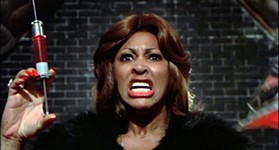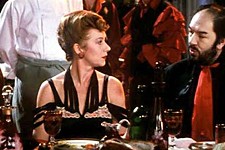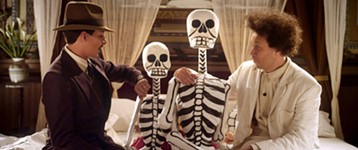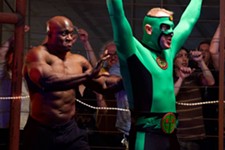The Pillow Book
1996, NR, 124 min. Directed by Peter Greenaway. Starring Vivian Wu, Yoshi Oida, Ken Ogata, Ewan McGregor, Hideko Yoshida, Judy Ongg.
REVIEWED By Marc Savlov, Fri., July 25, 1997
British director Greenaway (Prospero's Books, The Cook, the Thief, His Wife & Her Lover) has a cinematic style that's all his own, and this meditation on the vagaries of love, betrayal, and vengeance is rife with the man's peculiar take on life and filmmaking. Ostensibly the story of a young Japanese woman infatuated with the erotic possibilities of traditional Sino-Japanese calligraphy, Greenaway and his picture-perfect cast weave so many interlacing threads into the story, and so many curious subtexts -- stylistic and otherwise -- that it sometimes leaves us scratching our heads in wonderment. It's beautiful, but what does it mean? Wu plays Nagiko, who, upon first encounter, is a little girl in Kyoto. Every birthday, her father, an author, inscribes her face with intricate, gorgeous calligraphy while telling her the (Japanese) story of creation. During these early years, she becomes aware that an unscrupulous publisher has blackmailed her father: In exchange for the publication of his books, the publishers will withdraw certain sexual favors. This knowledge haunts the young girl as she grows up and eventually enters into a sort of high-brow, low-rent aristocracy amongst the bohemians in nearby Hong Kong. There, she seeks out a suitable lover who might be able to rekindle her passions through what might be called “full-body erotic calligraphy.” It's Sex and Zen minus the guffaws. When Nagiko finally runs into the expatriate British translator Jerome (McGregor), she's in heaven. Not only can he, after a bit of practice, do calligraphy with and upon her, he's also a brilliant lover. That's as much as I feel comfortable saying about Greenaway's plot for now -- his films are best entered into unawares (the title, however, comes from the Japanese slang for a diary). As one of the leading visual stylists in the world today, Greenaway infuses his work with maddeningly rich designs and set-pieces. Everything is related to everything else on screen, and this time out, more so than ever before, and more thrillingly to boot. In fact, as ambitious as The Pillow Book is, Greenaway has redefined the configuration of the screen entirely. Frequently, the director will have up to five different images running at once, although never in a format as banal as DePalma-style split-screen. Instead, he records several camera angles of the same shot and relegates them to the four corners of the movie screen, leaving the middle wide open for the master shot. On top of that (or below that, actually), run an unending series of subtitles, song lyrics, and other texts. I'm tempted to say it's le nouvelle vague all over again, but I'm afraid Claude Chabrol might kick my teeth in, so I won't. What it is is breathtaking moviemaking. Against all odds, it works, magically, transcendentally, perfectly. It's the shock of the new, once more, with feeling.
A note to readers: Bold and uncensored, The Austin Chronicle has been Austin’s independent news source for over 40 years, expressing the community’s political and environmental concerns and supporting its active cultural scene. Now more than ever, we need your support to continue supplying Austin with independent, free press. If real news is important to you, please consider making a donation of $5, $10 or whatever you can afford, to help keep our journalism on stands.
Marjorie Baumgarten, May 11, 2000
Aug. 7, 2022
April 29, 2022
The Pillow Book, Peter Greenaway, Vivian Wu, Yoshi Oida, Ken Ogata, Ewan McGregor, Hideko Yoshida, Judy Ongg










